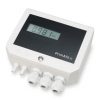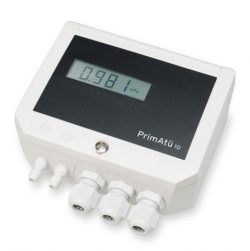
Maintaining precise environmental conditions is critical to the operational integrity of data centers. A key aspect of this is the management of air pressure within the HVAC system to ensure optimal cooling of IT equipment. This involves controlling the airflow from Computer Room Air Conditioning (CRAC) units through underfloor plenums, into the main data hall, and back through ceiling return plenums. A customer required a robust solution for monitoring these very low-pressure differentials to maintain efficiency and prevent hot and cold air mixing.
- Application: Monitoring low positive and negative gauge air pressures in three distinct zones of a data center: the sub-floor supply plenum, the main server room (above the raised floor), and the ceiling return air plenum.
- Challenge: The customer initially sought an “absolute” pressure reading for each zone but required individual gauge pressure measurements relative to a common, stable reference point to be meaningful for HVAC balancing.
- Solution: Utilization of a low-range bidirectional differential pressure transmitter for each measurement location, with one port sampling the target zone and the other vented to a common reference area, such as a corridor.
A customer managing a data center facility required a precise method for monitoring the air pressure dynamics essential for their hot aisle/cold aisle containment strategy. The application demanded simultaneous pressure measurements in the sub-floor plenum, which is used for distributing cold air from CRAC units; the main data hall above the raised floor; and the ceiling plenum, which serves as the return air path to the CRACs. Accurate monitoring of these pressures is fundamental to ensuring that conditioned air is delivered efficiently to server racks and that equipment does not overheat due to inadequate airflow or recirculation of hot exhaust air.
The initial request specified a need for “absolute” pressure values for each zone. However, in the context of building HVAC, measuring the absolute barometric pressure of a room provides little value for airflow control. The critical parameter is the gauge pressure of each zone relative to a stable reference. For instance, the sub-floor plenum must maintain a slight positive pressure relative to the main room to push cold air upwards through perforated floor tiles. A differential pressure instrument is the correct tool for this task, as it measures the pressure difference between two points. By leaving one of its pressure ports open to a common reference area, such as an adjacent corridor, the instrument effectively provides a stable gauge pressure reading for the monitored space.
The PrimAtü 10 series differential pressure transmitter was identified as the ideal solution. This instrument is specifically designed for detecting very small over-pressure, under-pressure, and differential pressures in non-aggressive gases like air, making it perfectly suited for HVAC applications. The core of the device is a piezoresistive silicon sensor that accurately converts the detected pressure into a proportional analogue output signal. For this data center application, a version with a bidirectional range, such as -4 to +4 inH₂O (-1000 to +1000 Pa), was selected, providing the necessary resolution to monitor both positive and negative pressure fluctuations relative to the reference point.
The versatility of the PrimAtü 10 series was a key advantage. The unit could be factory-configured with a 4-20mA analogue output, allowing for direct integration with the data center’s existing Building Management System (BMS) for centralized monitoring and control. Furthermore, the instrument features externally accessible buttons for zero point and amplitude (span) adjustment, a practical feature enabling technicians to easily calibrate the sensor in-situ during commissioning or routine maintenance. An optional integrated LCD display also provides significant value, offering immediate visual confirmation of pressure readings locally, which simplifies diagnostics and troubleshooting without requiring access to the BMS. The transmitter is housed in a robust IP65-rated enclosure with simple barbed pressure connections, ensuring reliable installation and long-term performance within the physical infrastructure of the data center’s plenums.

PrimAtü 10 Low Range Differential Pressure Transmitter
- Pressure Range: -4 to +4 inH2O (-1000 to +1000 Pa)
- Range Type: Bi-directional (-P to +P)
- Output Signal: 4-20mA
- Overall Accuracy: 2% FS
- Electrical Connection: Cable glands with internal screw terminals
- Process Connection: 6.6mm dia x 10mm barbed connections
- Media Compatibility: Non aggressive gases compatible with Ni, Al, CuBe, PU, silicon rubber
- Optional Extras: Integrated LC-display, 4 digit
